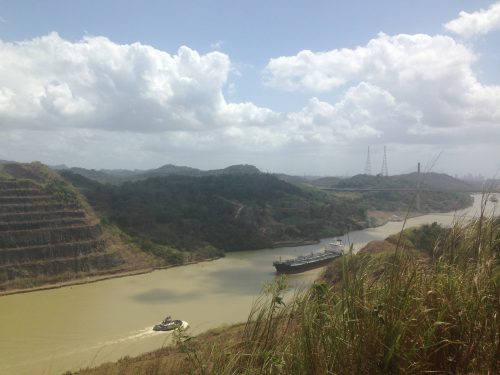
As we have heard, the visiting group from the University of Florida just got back from a visit to Panamá, during which much time was spent in the canal searching for fossils. The museum interns got their first taste of the Panamá sun! The trip went well, and many fossils were successfully uncovered.
In addition to fossil hunting, we were all able to visit the BioMuseo last week. While there, we learned a little more about the geologic history of Panamá. I enjoyed hearing more about the context of this important field area very much. After all, these fossils that we so desperately search for are part of a larger story, which I would like to talk briefly about today: the paleohistory of Panamá and the great implications of the closing of the isthmus.
The exhibit at the BioMuseo started at the very beginning, a very good place to start…
Before Panamá was a solid land mass, the area was made up of a volcanic arc, in form of underwater volcanoes caused by tectonic subduction. Pillow basalts, being the oldest rock found in Panamá, mark the beginning of this point in the paleohistory. A series of volcanic and plutonic rocks formed during this whole process. These underwater volcanoes eventually grew into small surfaced islands as they were uplifted. This began the process of sedimentation on top of the complex crystalline basement.
![Posing with some prehistoric animals at the BioMuseo. [L-R: Sonia, Sophie, Adam]](https://www.floridamuseum.ufl.edu/wp-content/uploads/sites/77/2015/03/fullsizerender-350x500.jpg)
In closing, while at the BioMuseo, we made a contact who would like for us to help make a narrative talking about the paleohistory of Panamá from a geologic standpoint. In addition, we might try and organize workshops or even field trips to the canal for museum visitors. The goal would be to present a more understandable, detailed, and interesting geologic account of the region. As this is a more obscure and difficult topic, they would like our help to get people interested in it. The four of us are very excited, as much of our training has been in geology. We will keep you updated on this process!
Thanks and, of course, Go Gators.
~Sonia~
References:
– BioMuseo, Panamá
– Montes, C. et al. Arc-continent collision and orocline formation: Closing of the Central American seaway. J. Geophys. Res. Solid Earth 1978–2012 117, (2012).
Hi, I would like to be part of your search team. What are the possibilities?
Thank you
In Panama, the Smithsonian Tropical Research Institute (STRI) and the BioMuseo both deal with geology and paleontology. Here are a couple of links for volunteering with STRI and the BioMuseo that may be useful: http://www.stri.si.edu/english/research/volunteers/
http://www.biomuseopanama.org/en/webform/volunteer-program
The Geologist that surveyed the Panama Canal in its beginning wrote that the area around Zoo had been under water four times in recent geological history. I do not understand what recent means. Plus that would mean that it rises and falls.
Recent geological history depends a lot upon context. It usually refers to a few million years, but can extend through the entire Cenozoic (65 million years!). It’s a much longer time frame than what humans are used to dealing with. Sea level rises and falls depending on numerous factors, including the amount of ice cover in the polar regions (more ice = lower sea level) and tectonic forces (deeper oceans = lower sea level).
You might also look into the passing of Cuba from the Pacific Ocean to the Atlantic Ocean via what would one day be Panama. Fossils found on Cuba point to the Pacific and no other island in the Atlantic have these Pacific fossils.
Cuba does have some different fossils! We are looking into the timing of the closing of the isthmus, shutting off the oceanic connection between the Atlantic and Pacific Oceans.